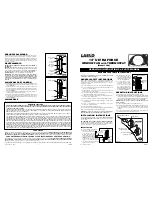
Operating instructions
W3G300-ZG06-01
Translation of the original operating instructions
CAUTION
Voltage
The fan is a built-in component and has no disconnecting switch.
→ Only connect the fan to circuits that can be switched off with
an all-pole disconnection switch.
→ When working on the fan, secure the system/machine in
which the fan is installed so as to prevent it from being
switched back on.
NOTE
Water ingress into wires or cables
Water ingress at the customer end of the cable can damage the
device.
→ Make sure the end of the cable is connected in a dry
environment.
Only connect the device to circuits that can be switched off with
an all-pole disconnection switch.
4.2.1 Requirements
;
Check whether the information on the nameplate matches the
connection data.
;
Before connecting the device, make sure the power supply matches
the device voltage.
;
Only use cables designed for the current level indicated on the
nameplate.
For determining the cross-section, note the sizing criteria according
to EN 61800-5-1. The protective earth must have a cross-section
equal to or greater than that of the phase conductor.
We recommend the use of 105 °C cables. Ensure that the minimum
cable cross-section is at least
AWG 26 / 0.13 mm².
Protective earth contact resistance according to EN 60335
Compliance with the resistance specifications according to EN 60335 for
the protective earth connection circuit must be verified in the end
application. Depending on the installation situation, it may be necessary
to connect an additional protective earth conductor by way of the extra
protective earth terminal provided on the device.
4.2.2 Reactive currents
Because of the EMC filter integrated for compliance with EMC
limits (interference emission and immunity to interference),
reactive currents can be measured in the supply line even
when the motor is at a standstill and the line voltage is switched
on.
●
The values are typically in the range < 250 mA
●
At the same time, the effective power in this operating state
(operational readiness) is typically < 4 W.
4.2.3 Residual current circuit breaker (RCCB)
If the use of a residual current device (RCD) is required in your
installation, only AC/DC-sensitive residual current devices
(type B or B+) are permissible. As with variable frequency
drives, residual current devices cannot provide personal safety
while operating the device. When the device power supply is
switched on, pulsed charging currents from the capacitors in the
integrated EMC filter can lead to the instant tripping of residual
current devices. We recommend the use of residual current
circuit breakers (RCCB) with a trip threshold of 300 mA and
delayed tripping (super-resistant, characteristic K).
4.2.4 Basic insulation of the alarm relay
As the alarm relay only has basic insulation (for TN/TT
systems) or functional insulation (for phase-conductor-grounded
networks) with respect to the supply voltage, and not double
insulation like the rest of the interface, corresponding precautions
must be taken for industrial applications (EN 61800-5-1).
→ The voltage switched by the alarm relay (e.g. 24 VDC)
must then have no electrical connection to the 10 V output, 0-
10 V control input and GND (electrically isolated interface).
4.2.5 Locked-rotor protection
Due to the locked-rotor protection, the starting current (LRA) is
equal to or less than the nominal current (FLA).
4.3 Connection in terminal box
4.3.1 Preparing cables for connection
Only strip the cable as far as necessary, ensuring that the cable gland is
sealed and there is no strain on the connections. For tightening torques,
see Chapter 3.1 Product drawing.
NOTE
Tightness and strain relief are dependent on the cable
used.
→ This must be checked by the user.
4.3.2 Connecting wires to terminals
WARNING
Live terminals and connections even with device
switched off
Electric shock
→ Wait five minutes after disconnecting the voltage at all poles
before opening the device.
;
Remove the cap from the cable gland.
Only remove caps where cables are fed in.
;
Route the wire(s) (not included in scope of delivery) into the terminal
box.
;
First connect the "PE" (protective earth).
;
Connect the wires to the corresponding terminals.
Use a screwdriver to do so.
When connecting, ensure that no wire ends fan out.
;
Fit the terminal box cover so that the arrow points towards the cable
glands.
;
Seal the terminal box.
Item no. 57963-5-9970 · ENU · Change 212910 · Approved 2021-04-01 · Page 9 / 14
ebm-papst Mulfingen GmbH & Co. KG · Bachmühle 2 · D-74673 Mulfingen · Phone +49 (0) 7938 81-0 · Fax +49 (0) 7938 81-110 · [email protected] · www.ebmpapst.com
































